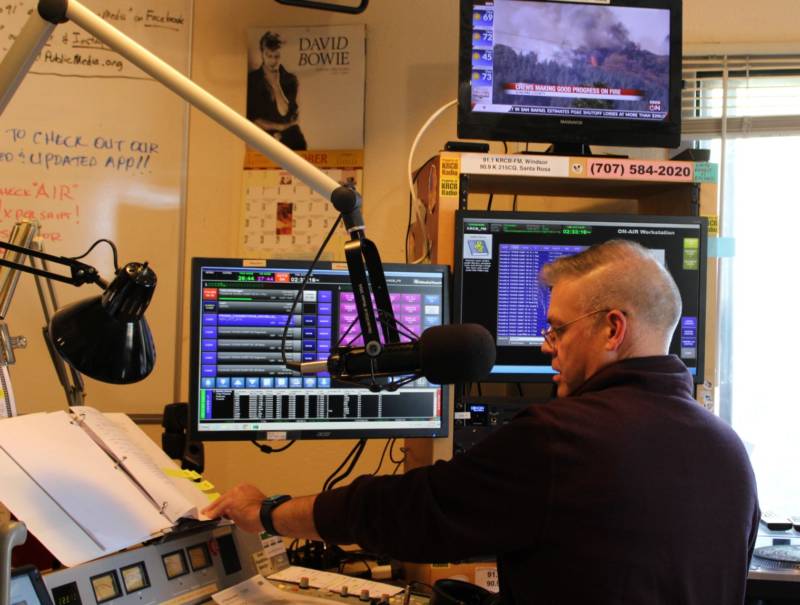The Kincade Fire is 100 percent contained. Emergency officials are earning praise for the way they communicated evacuation orders and health advisories. But, along with mobile phone and social media alerts, the humble 100-year-old technology of radio proved its value again.
It’s reliable when everything else — the electrical grid, internet, cell service — is down. Radio can immediately relay information if it’s got backup power. It doesn’t require anyone to edit text or add visuals. And, during times of crisis, it calms anxious listeners eager to hear a familiar voice.
Tami Scharff of Santa Rosa says she never thought her town would face another crisis just two years after the wildfires of 2017.
“Unfortunately,” she says, “it was, OK, here we go again. And I really just right away go to KSRO.”
KSRO is a News-Talk radio station in Sonoma County. Two years ago and again this Fall, it offered rolling, 24/7 wildfire coverage, taking listener calls and amplifying officials and emergency responders on air.
“In 2017 it was such a lifeline,” Scharff says. “We were in an evacuation warning from the first day on.”
For days she carried in her car everything she planned to take in case that warning became an order.
“And I remember when the Annadel Fire was going on right near our home, I kept saying to my husband, ‘If I see flames, we’re going.’ ” Scharff says.
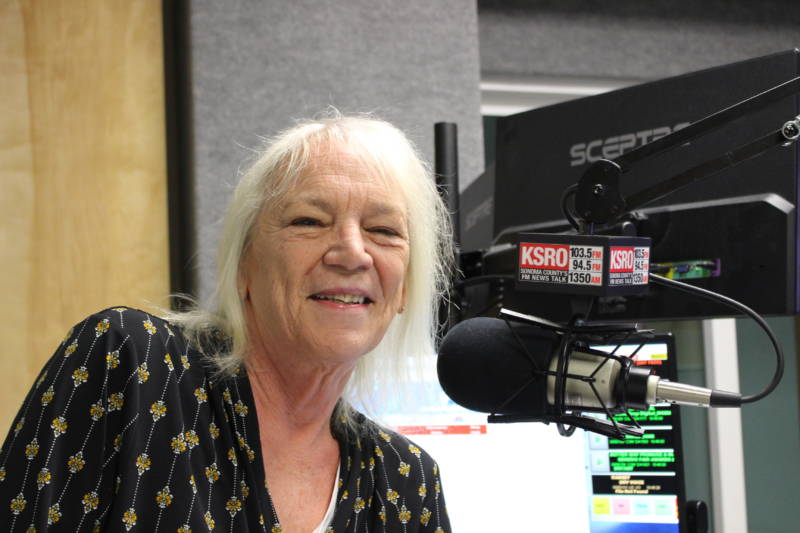
“All of a sudden, a huge [smoke] plume came up and I say, ‘We’ve got to go, we’ve got to go!’ Right then, I hear on the radio, which I had on the whole time, saying ‘Bennett Valley people, it’s a back fire!'”
Firefighters had set it on purpose to stop approaching flames. There was no need to evacuate. Scharff says she and her husband sighed with relief.
“Having the radio on, telling us what was going on minute-by-minute. It was so, so vital when you’re going through something like that.”
A Personal Connection
Steve Garner normally hosts a gardening and a culinary show on KSRO. But when he needs to, he steps easily into the role of news anchor.
“You have to be a rock,” he says. “You have to reassure people that it’s going to be OK. You have to make sure you don’t jump the gun and give out inaccurate information.”
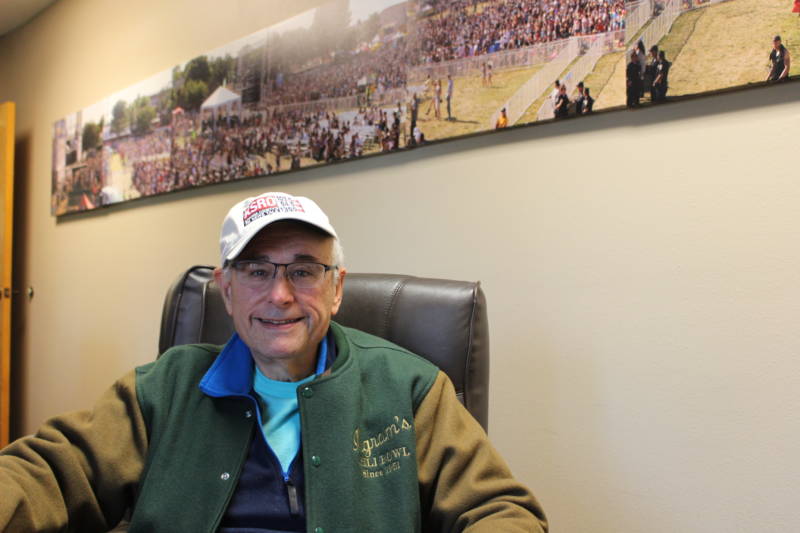
Garner points to social media as an irritating source of incomplete, inaccurate or speculative information about what the first responders were doing.
“While they were out putting out literal fires, we were putting out fires because of misinformation, squelching the rumor line.”
There’s another reason people tune in, he says.
“Radio is about a personal connection. Hearing people’s voices rather than just reading their words.
“When I was on air I tried to balance the hard news, the hard interviews and something I saw in the community that was heartwarming, for instance when someone that told me they had just been reunited with their pet,” Garner says. “These are the stories that humanize us and bring us together and and momentarily can distract us enough to remember that this, too, will pass.”
Lessons from 2017 Pay Off in 2019
Redwood Empire Stereocasters owns five broadcast stations with formats from country to jazz. During 2017, and again this year, the stations merged their streams and provided continuous news coverage.
“We didn’t have a plan in 2017,” says general manager Frank Kulbertis. “It was haphazard and fly by the seat of our pants.”
This time, he says, his staff prepared for the task. He keeps on his desk a binder with emergency contacts for emergency and locally elected officials.
“When this broke out this time, it was kind of easy for me hop on the phone and line these people up to be on air and tell us what was going on,” Kulbertis says.
With an emergency staffing plan in place, everyone took on new job roles. He booked interviews and updated the website.
“We had on air-personalities that are typically doing music and happy talk and that sort of thing doing serious news reports,” the general manager recalls. “We had people from our sales staff who normally are trying to sell advertising, spending time on phones and online, contacting public officials, gathering information and getting notes into the studio.”
In preparation, the stations also outfitted the studios with two large generators, and installed generators at each of their tower sites. They were never off the air.
Fire Hits a Transmitter
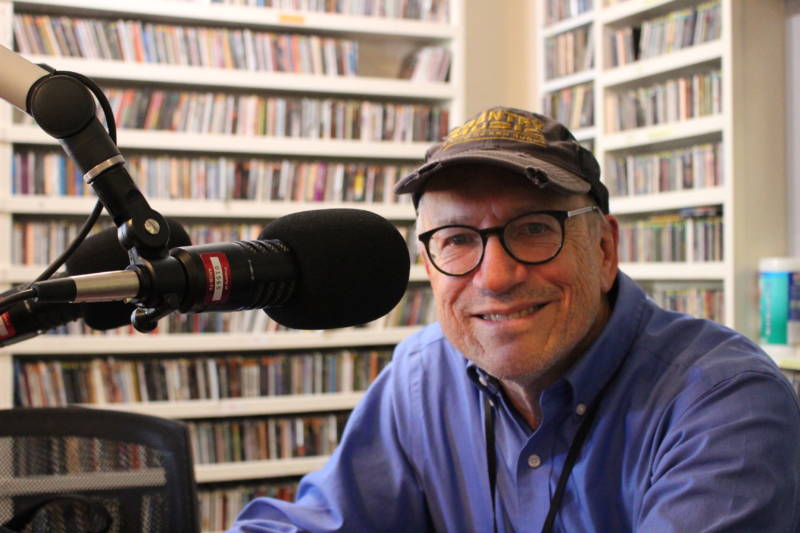
That wasn’t the case for all of Sonoma County’s local stations. NPR member station KRCB 91-FM transmits on two frequencies: 90.9 and 91.1. After the Kincade Fire exploded on the night of Oct. 23, program director and operations manager Sean Knight was in his car and couldn’t hear his station on its 91.1 frequency.
“It was just off and I thought, ‘Well, that’s different.'”
A few calls and a little investigating indicated that the transmitter, 1,700 feet above sea level in the Geyser Hills area, had burned. The station had installed the high-definition transmitter in March.
Nature also took down the station’s previous set up, Knight says.
“It got knocked down in the rainstorms back in January. So we just got it replaced.” Knight adds. “We can’t catch a break with that thing.”
The transmitter loss reduced the station’s reach over the air. Still, like its commercial counterparts, KRCB stayed on the air throughout the wildfires.
“We still had 90.9, and all of our social media, and streams and the apps,” he says. “So I just said, ‘Keep the news flowing, and when there’s no news play some music.'”
In the meantime the station contacted NPR in Washington, D.C.. This year, the network created a program to supply temporary backup transmitters and antennas to stations that go off the air during emergencies.
Knight shows me the new replacement, set up in the station’s backyard in Rohnert Park. To the untrained eye it looks like a thick silver paper clip high up on a tower.
He proclaims: “We’re calling it Junior.”
91.1 FM is back up and running.
Radio Rises Again
Justin Lane lives in Cotati. He and his family lost electricity, internet and cell service. They found emergency alerts “basically unusable.”
If PG&E shuts off power again for an extended period of time, he’s not counting on using his phone.
“Moving forward, I’m just going to brace for the worst,” Lane says. “We’ve got a battery- operated radio now, which is great as long as the radio stations kind of keep doing what they did this last time, keeping us updated constantly.”
That’s one reason the American Red Cross recommends that everyone’s emergency kit includes a radio.
After the 2017 North Bay Fires, the Napa County Grand Jury convened an investigation into what worked and what didn’t work in saving lives in Napa. The report reads, in part: When the power went out, and the public could no longer receive information from TV, the Internet or Nixle, it was old technology that saved the day. Residents got in their cars or dug out their battery powered radios to tune in to KVON.
“I really think that old school radio has been far too often overlooked too, because it is a major channel to reach the people who need it to get a mass message in a mass disaster,” says Doug Carlson, a former reporter and public information officer who advocates for improved communications during wildfire crises.
“It has worked for the last hundred years and we can’t ignore it going forward.”
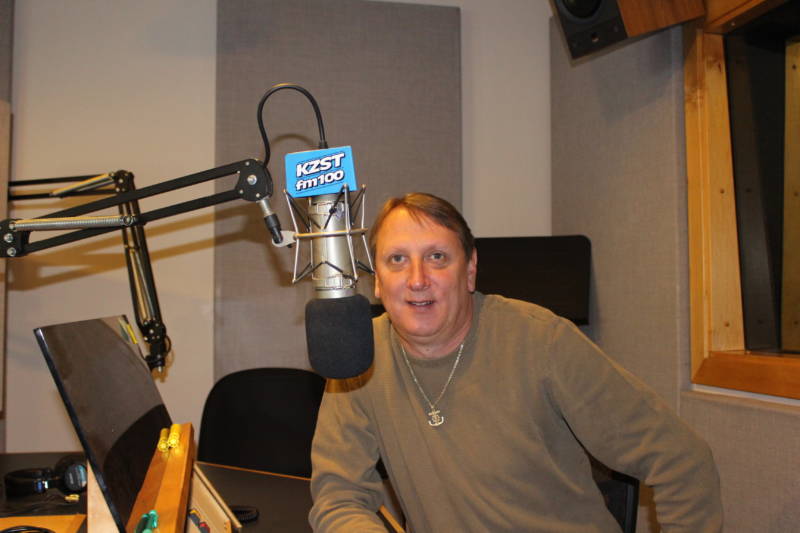
On KZST, Mike Adams normally plays three decades of pop hits. When the station and its affiliates switched to fire coverage, he became part reporter, part emergency coordinator.
“We’re the ones that are going to give you the information you need,” he says. “We’re the ones that are are gonna be there for you when you call.”
Adams remembers a call from an elderly couple trying to evacuate their neighborhood and drive to safety. “They were broke down on the side of the road and they needed help.”
Unsure about what to do, they called the station.
“And you can see me tearing up over this,” Adams says“A listener pulled up and helped them. They got taken care of.”
Now that the emergency’s wound down, KZST, KSRO and other North Bay stations are back to their normal programming.
As they do, the boost in listenership will likely subside. That’s too bad, Kulbertis says, adding, “I wish it didn’t take circumstances like these for people to understand the value of radio.”
You can count on it, even though it’s not the newest technology.
“I mean, I honestly think we are the Rodney Dangerfield of all media,” he sighs. “We get no respect except maybe at times like this and then it’s fleeting.”
Until…of course…next time.
KQED’s Miranda Leitsinger contributed reporting to this post.
